1 What is Aerospace Engineering?
Introduction
The word engineering is derived from the Latin words ingeniare (“to create, generate, contrive, devise”) and ingenium (“cleverness”). Aerospace engineering is a field concerned with designing, constructing, testing, and operating all types of flight vehicles, including their propulsion systems. Engineers in this field primarily focus on developing strong yet lightweight vehicles that can achieve successful and efficient atmospheric or space flight.
Aerospace engineering comprises two primary branches: aeronautical engineering (aeronautics) and astronautical engineering (astronautics). Aerospace engineers typically specialize in either aeronautical or astronautical fields.
- Aeronautical engineering or aeronautics is the field associated with designing and building atmospheric flight vehicles, i.e., aircraft that fly within the normal confines of the Earth’s atmosphere and are propelled by air-breathing engines.
- Astronautical engineering, also known as astronautics, is the field associated with designing and building various types of exo-atmospheric vehicles, including rockets, launch vehicles, missiles, satellites, and other spacecraft. These flight vehicles are designed primarily to fly beyond the limits of the Earth’s atmosphere or in outer space and are propelled by rocket engines, i.e., non-airbreathing engines.
Learning Objectives
- Understand some of the primary disciplines and activities pursued by engineers working in aeronautics and astronautics.
- Know more about the myriad multidisciplinary technical problems that aerospace engineers face.
- Better appreciate some of the roles and responsibilities of an aerospace engineer.
So, You Want to Be an Aerospace Engineer?
Newcomers must appreciate that aerospace engineering is a highly applied field focused on the practical aspects of designing, building, and operating flight vehicles. Aerospace engineers work on a broad range of technical tasks, including designing aircraft and spacecraft, selecting materials and propulsion systems, and testing and operating these vehicles. Goals in aerospace engineering also include making flight vehicles safer, more efficient, and more cost-effective.
According to the U.S. Bureau of Labor Statistics, aerospace engineers with degrees or other professional qualifications are employed in many businesses and organizations, including private industry and government labs. In addition, aerospace engineers are performing a diverse range of engineering activities related to:
- The design and construction of airframes, engines, and various aircraft or spacecraft products.
- Other types of sub-component parts manufacturing.
- Engineering services and other support services.
- Research and development.
- Government and military labs, such as those at NASA, the Army, and the Air Force.
Many practicing aerospace engineers transition into education and training roles, sharing their expertise with students and helping to train the next generation of engineers. These engineers may also continue to conduct research and development work to advance the field, providing specialized training to graduate engineers and helping them become future leaders in their respective fields. Through their career in academia and research, they help to ensure the continued growth and development of the aerospace industry.
To successfully design any aircraft or spacecraft requires a detailed understanding of many fundamental engineering disciplines, which will include (but are not limited to):
- Fluid dynamics and aerodynamics.
- Propulsion systems, both air-breathing and rockets.
- Structures, materials, structural dynamics, and aeroelasticity.
- Electronics, electrical systems, and avionics.
- Acoustics (noise), both external and internal.
- Flight dynamics and flight control systems.
- Orbital mechanics.
- Software and software engineering.
- Other factors include economics, human factors engineering, safety considerations, regulations, airworthiness, and certification, among others.
Therefore, it becomes immediately apparent that aerospace engineering is multifaceted, multidisciplinary, and interdisciplinary, and successful engineers must have a deep understanding of many subjects. In this context, the term multidisciplinary refers to engineers working across multiple disciplines that involve aerospace problem-solving. The word interdisciplinary means synergistically combining or applying several fields or specializations to solve these problems.
Aeroelasticity is just one interdisciplinary subject important for all flight vehicles because their structures elastically deform under aerodynamic and inertial loads, i.e., the consideration of aerodynamic/structure interactions. Specifically, flutter is an example of undesirable aeroelastic behavior of lightweight and flexible elastic structures that must be avoided during airframe design. Similarly, acoustics is another interdisciplinary field relevant to flight vehicles. It involves the study of sound generation, propagation, and interaction originating from aerodynamic loads, which is critical in understanding noise control, passenger comfort, and structural responses in aerospace systems.
While it can be appreciated that aeronautical and astronautical engineers usually face different specific problems and design challenges (i.e., those associated with aircraft versus spacecraft), the two fields overlap considerably. This overlap arises because both specialties depend on a detailed understanding of the same fundamental engineering principles. Understanding these essential disciplines and using them effectively requires that aerospace engineers have a deep knowledge of physics, chemistry, mathematics, numerical methods, and computer programming. It also requires a solid understanding of statics, mechanics, kinematics, fluid dynamics, acoustics, thermodynamics, materials science, electronics, and other relevant disciplines.
Today, understanding computer languages such as MATLAB, C++, FORTRAN, and Python is essential for all aerospace engineers. In addition, routine engineering problem-solving often centers around computer programming and specialist software to display results and seek understanding, e.g., with the help of Tecplot, FieldView, etc.
What is the difference between MATLAB and FORTRAN?
MATLAB is a medium-level programming language with subroutine libraries and many built-in tools. Still, it is proprietary software, which significantly restricts the portability and sharing of the code. FORTRAN is a high-level programming language, and the compiler is open-source. Developing FORTRAN code may take a bit longer, but the final executable may be orders of magnitude faster than what is possible with MATLAB. Many production-level engineering codes use FORTRAN.
Roles of Aerospace Engineers
Aerospace engineers possess the training and skills to lead the development of new aircraft and spacecraft, as well as to improve their numerous subsystems. The U.S. Bureau of Labor Statistics indicates that aerospace engineers primarily design aircraft, spacecraft, satellites, and missiles. Also, they test aircraft prototypes and their subsystems to ensure they function according to their design specifications. Aerospace engineers are usually considered to have the following roles and responsibilities:
- Direct and coordinate the design, manufacture, and testing of all types of aircraft and spacecraft and their associated components and systems.
- Determine through engineering analysis that the proposed projects will result in safe aircraft, spacecraft, and all associated parts.
- Evaluate designs to ensure the products comply with sound engineering principles, customer requirements, regulations, and environmental challenges.
- Conduct ground, flight, and wind tunnel testing of new designs.
- Develop acceptance criteria for design methods, quality standards, sustainment after delivery, and completion deadlines.
- Ensure that projects meet the standards of quality control and certification authorities.
- Inspect malfunctioning or damaged products to identify sources of in-service problems and possible airworthiness solutions.
- Assess project proposals to determine if they are technically and financially feasible.
- Lead and direct research to gain a deeper understanding of and advance the field.
An aerospace engineer’s role is much broader than just traditional engineering tasks. They may also be involved in consulting, education, and teaching, as well as managing, addressing legal and regulatory issues, and advising on future aerospace goals and long-term research strategies. The field is constantly evolving, and aerospace engineers may find themselves taking on a diverse range of responsibilities and opportunities.
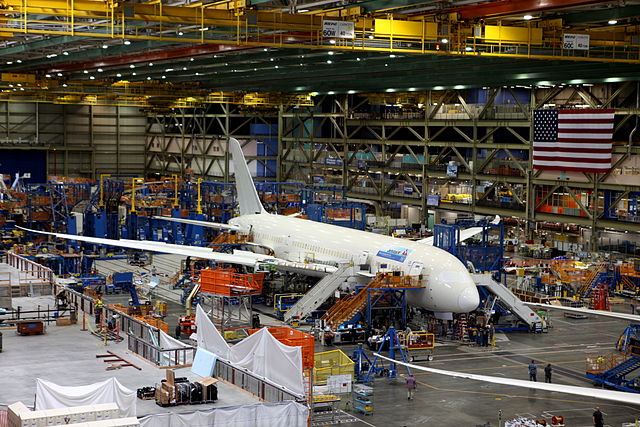
The aerospace industry has undergone rapid evolution over the last century, driven by technological advances that have led to the development of increasingly complex aerospace systems. Today’s aerospace systems must meet a wide range of demands, including customer specifications, operational requirements, and regulatory requirements. These systems can range from large airliners to small personal and autonomous aircraft, and they must be designed and manufactured to meet these demands while ensuring safety and reliability. The evolution of technology and customer needs drives continued innovation and growth in the aerospace industry.
While autonomous or semi-autonomous drones, often referred to as Uncrewed Aerial Vehicles (UAVs), still face numerous design and operational challenges, they are likely to experience widespread adoption in the coming decades. Aviation and space activities will still require multiple innovations and advances in engineering technologies to meet the growing demands for more functional, efficient, and environmentally friendly flight vehicles.
Aerospace engineers play a vital role in developing new technologies for aircraft and spacecraft. Still, they often work in teams with other types of engineers, such as mechanical and electrical engineers. After graduation, aerospace engineers may specialize in one or more sub-disciplines of the field, including aerodynamics, computational fluid dynamics, structural design, materials and metallurgy, performance, stability and control, flight control systems, propulsion systems, aeroelasticity, acoustics, wind tunnel testing, flight testing, non-destructive testing, and system integration. These specializations enable them to gain in-depth expertise in specific areas of aerospace engineering, contributing to the development of new technologies and solutions that advance the field.
Developing new flight vehicle designs requires a significant investment in testing and verification to ensure they meet or exceed certification requirements. Over-designing can be a considerable cost factor for companies, so aerospace engineers must balance the need for safety and reliability with cost considerations. Additionally, aerospace engineers can specialize in various types of aerospace products, including commercial or military airplanes, helicopters or other rotorcraft, UAVs and drones, spacecraft such as launch vehicles and satellites, and engines or other propulsive power systems. This specialization enables them to gain in-depth knowledge and experience in a specific area of aerospace engineering, leading to more effective and efficient designs and innovations.

Engineering Problem Solving
Problem-solving is an essential skill for aerospace engineers. Aerospace engineers must be able to identify, formulate, and solve complex problems systematically and effectively. This requires a strong foundation in engineering fundamentals, mathematics, experimentation, and a deep understanding of the relevant rules and principles that can be applied to find a solution.
Developing problem-solving skills is an integral part of an aerospace engineering education. Students can improve these skills by practicing and solving homework problems, working on projects, and completing assignments that require them to apply their knowledge and skills to real-world situations. They can hone their problem-solving abilities by continuously challenging themselves, thereby becoming skilled and confident aerospace engineers.
Sometimes, the problems engineers encounter are so new and different that they require fundamental or foundational research, so they may only have a longer-term solution. Aerospace engineers must take a holistic and interdisciplinary approach to problem-solving. They must be able to consider not just the technical aspect of a problem but also the broader implications and trade-offs of their solutions. Practical oral and written communication skills are also crucial in this field, as aerospace engineers frequently work in teams and must present their ideas and findings to both technical and non-technical audiences. Furthermore, in today’s world, understanding the impact of any engineering solutions in a global, economic, environmental, and societal context is also needed. Not all engineering solutions may prove to be practical for these latter reasons.
The complexity of modern aircraft and spacecraft necessitates the integration of traditionally separate engineering disciplines during the design process to achieve a more optimized outcome, a process known as multidisciplinary design. All new engineers must acquire a deeper and broader engineering background and be effective as part of an engineering problem-solving team.
As aerospace technology continues to advance, the role of aerospace engineers will continue to evolve. In addition to developing new technologies, they will ensure that the systems they design are safe, efficient, and environmentally friendly. With a continued emphasis on interdisciplinary collaboration and the integration of technology and design, the future of aerospace engineering is bright and holds tremendous potential for innovation and progress. The aerospace industry will continue to require highly skilled and motivated engineers who can meet the ever-increasing challenges of designing and manufacturing the most advanced aircraft and spacecraft possible.
Aerodynamics: The Underpinning of Flight
Aerodynamics is a crucial aspect of aerospace engineering and the foundation of all atmospheric flight. It deals with the motion of air and its impact on the performance of aircraft and other aerospace systems. The word “aerodynamics” is derived from the Greek words “aero,” meaning air, and “dynamis,” meaning the study of matter in motion. Aerodynamics plays a critical role in the design and optimization of aerospace vehicles.
Aerodynamics is a crucial field for both aeronautical and astronautical engineers to study. Aeronautical engineers focus on understanding the aerodynamic effects produced on objects moving through the air, such as wings and complete aircraft. In contrast, astronautical engineers focus on all aspects of propulsion, including the dynamic loads generated by rockets, satellites, and spacecraft, as well as their guidance and control systems. However, astronautical engineers must also address aerodynamic issues during the spacecraft’s launch and re-entry phases. A thorough understanding of aerodynamics is essential for designing efficient, stable, and safe aerospace vehicles.
More specifically, the types of problems encountered in the field of aerodynamics may include:
- The prediction and measurement of aerodynamic forces on airfoils, wings, fuselages, engine nacelles, and entire airplanes. These types of problems are classified as external aerodynamics.
- The prediction and measurement of aerodynamic loads and kinetic heating on high-speed flight vehicles, ranging from supersonic and hypersonic aircraft to rockets, spacecraft, satellites, re-entry vehicles, and probes entering the atmospheres of other planets.
- Determining the characteristics of flows moving through ducts, pipes, and channels, e.g., through hydraulic or pneumatic systems, or the flow conditions produced in wind tunnels. The preceding are examples of problems in internal aerodynamics.
- Understanding and predicting flow properties into and inside rockets and air-breathing jet engines, such as calculating thrust values, pressures, temperatures, etc.
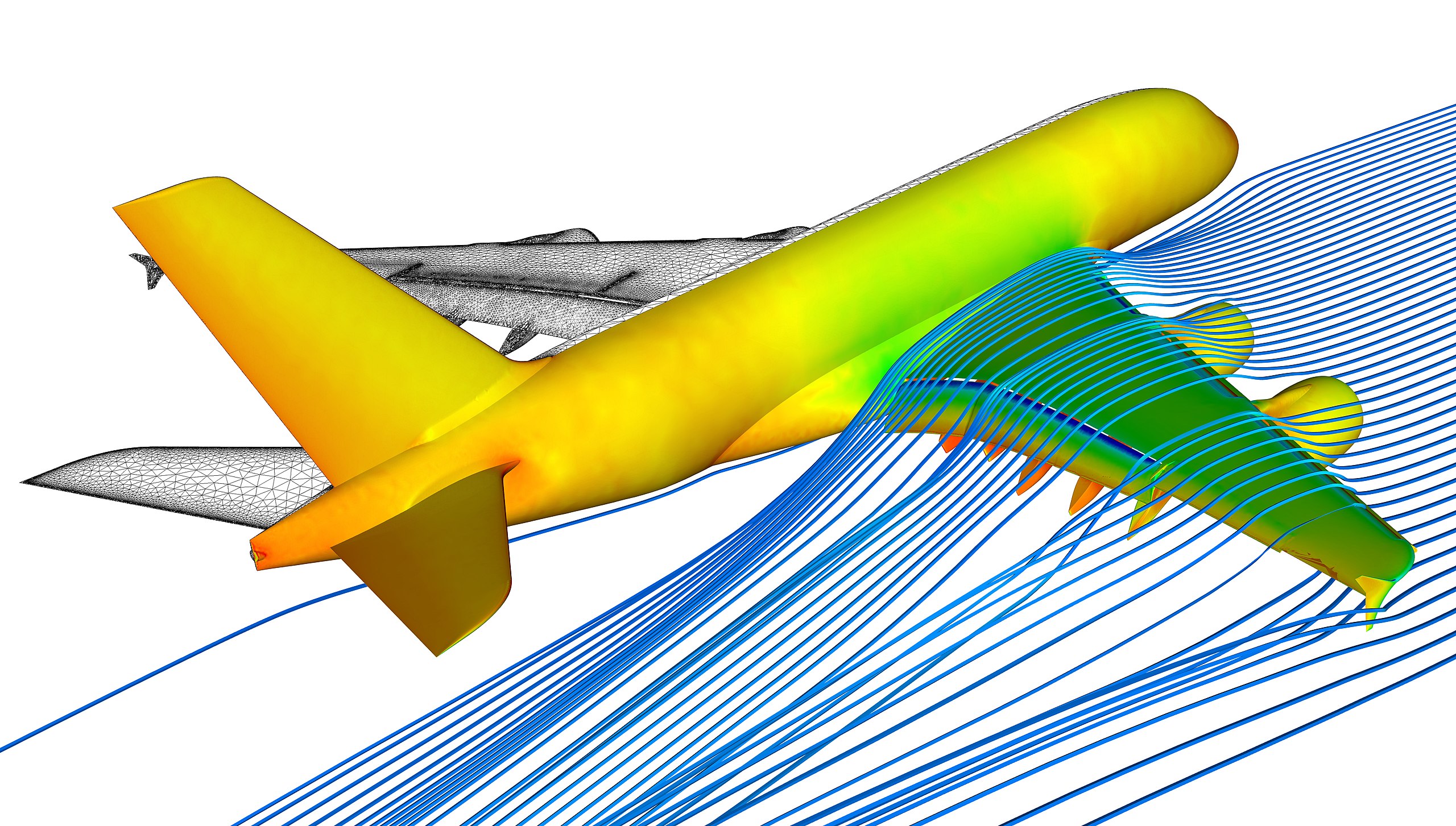
Propulsion Systems: The Power for Flight
Propulsion involves studying the design and operation of propulsive systems, including air-breathing and rocket engines. All flight vehicles require a source of power to achieve flight. Aerospace engineers continually strive to develop engines with increased thrust, power, and efficiency, thereby making them more durable and reliable. Engineers also aim to design and build as small and lightweight engines as possible, a goal that continues to present numerous engineering challenges from both design and manufacturing perspectives. Therefore, propulsion engineers must be well-versed in thermodynamics, fluid mechanics, combustion, heat transfer, dynamics, vibration, and materials science.
Until the beginning of the 20th century, sustained, powered, heavier-than-air flight remained impossible because of the lack of suitable engines. The development of the internal combustion engine in the piston (or reciprocating) engine soon led to rapid advances in engine technology, including increases in their power-to-weight ratio, which enabled them to be developed for aeronautical use. Developments in high-strength and high-temperature metals, suitable for use in engines, as well as the introduction of supercharging, soon led to improvements in reliability and power output, with better-performing aircraft following quickly. Turbojet engine developments during WWII revolutionized aviation, enabling new aircraft to fly increasingly faster and higher.
Propulsion systems for today’s aircraft have undergone a significant evolution over the last two decades. Advanced turbofan engines produce massive amounts of thrust with excellent fuel efficiency. They can operate continuously for tens of thousands of flight hours at transonic Mach numbers, up to seven miles high, without mechanical problems.
More specifically, the types of engineering problems encountered in the field of propulsion systems may include:
- The design, development, and improvement of all types of air-breathing engines, such as new generations of piston engines, turbojets, turbofans, and turboprops.
- Predicting the fluid dynamics of high-speed internal flows, including the effects of thermodynamics and the combustion processes associated with engine operations.
- The design, testing, and manufacturing of engine components, including inlets, compressors, combustion chambers, turbine blades, and various types of nozzles.
- Research into the use of new types of fuels, such as biofuels, hydrogen fuel cells, or hybrid fuel systems, and ways of improving an engine’s fuel efficiency.
- The design of fans, nozzles, and other engine components to ensure efficiency and low external noise levels.
- The design of electric propulsion systems, including lightweight, high-torque electric motors and advanced propellers with high propulsive efficiency and low noise.
- Improvements in rocket propulsion systems, including solid rocket engines, liquid rocket engines, hybrid rockets, and possibly advanced nuclear propulsion systems.
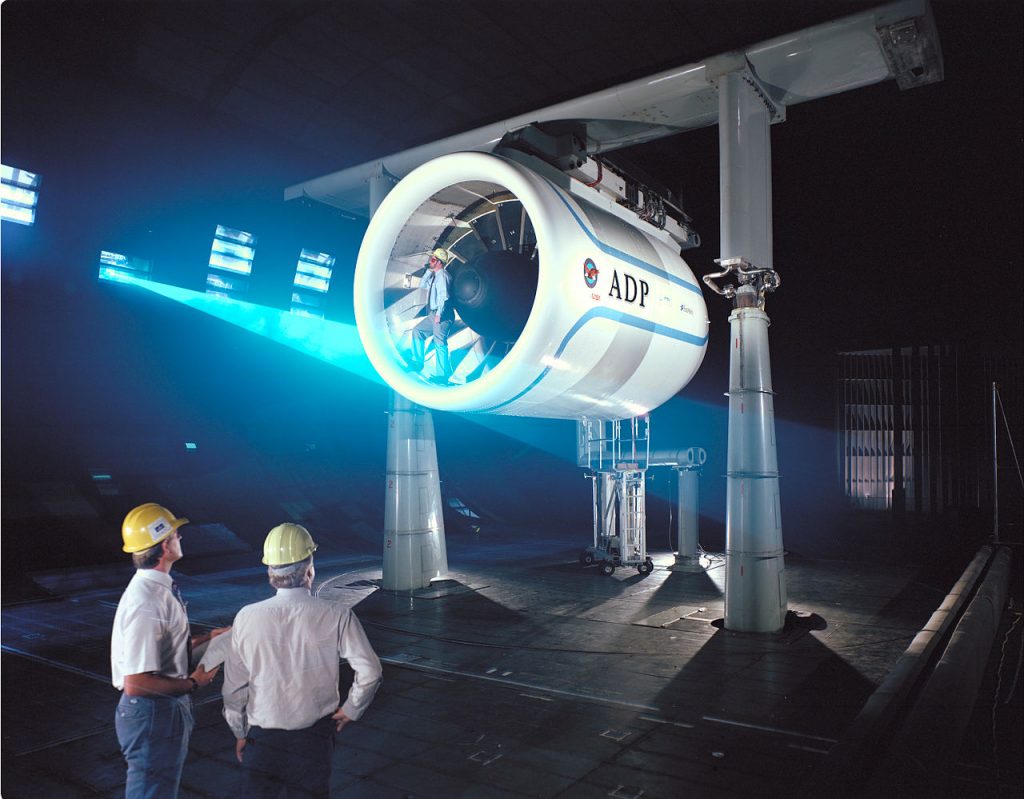
Structures and Materials: Carrying the Loads
In the field of structures and structural mechanics, aerospace engineers study the mechanical behavior of aircraft and spacecraft structures. Aerospace structures differ from other engineering structures because they need high strength and extreme lightness. To this end, aerospace engineers work with thin-walled metallic structures made of aluminum and other lightweight metallic alloys, as well as advanced composite materials and perhaps various types of multifunctional or “smart” materials.
Composite materials have the main advantage of tailoring their fibers in the direction of the load paths, allowing a structure to be built with a higher strength-to-weight ratio. Composite materials also exhibit significantly improved fatigue life compared to metallic structures. A multifunctional material is a hybrid material that combines parts with multiple functions, such as load-carrying capabilities and energy storage, or load-carrying properties with electrical or thermal conductivity. Multifunctional materials in aerospace applications offer better structural weight and volume efficiency.
A thorough understanding of material properties and their limitations is essential for achieving the desired performance levels in aerospace flight structures. Both aeronautical and astronautical engineers must be knowledgeable in the theory of structures and the properties of materials. They employ advanced numerical methods, such as the finite element method (FEM), to perform various computations and experiments on structures. They may also encounter practical implementation challenges with the structural components of aircraft and spacecraft. In this area of specialization, a thorough knowledge of material properties, structural analysis, and practical implementation is required to design and maintain safe and effective aerospace flight structures.

The types of problems encountered in the field of aerospace structures and structural mechanics may include the following:
- The selection and characterization of advanced materials and material/structural design for new aircraft, spacecraft, and engine designs.
- Understanding the material and structural stability under diverse loading conditions, particularly when combined with high bending, torsion, and compression, as well as aero-thermal loads, may require careful design optimization of the structure.
- Developing methods to predict and understand structural dynamics and aeroelasticity, which deals with time-varying structural deformations and their interactions with aerodynamics, is essential for very light and potentially flexible aircraft.
- The development of various shape-changing or morphing structures may utilize embedded actuators within the structure to progressively change its shape, meeting the varying and diverse flight requirements. Deploying wing flaps for takeoff and landing is an excellent example of where the wing shape needs to be changed or morphed.
- The development of structural health monitoring and management systems utilizes sensors and data processing algorithms to verify the integrity of critical flight structures and identify the actual locations of internal structural damage, such as fatigue cracks. The main advantage of health monitoring is that it gives ample warning of any impending mechanical or structural malfunction or failure.
Flight Dynamics & Control: Flying on Course
The field of flight dynamics and control concerns the motion of all flight vehicles, whether in the atmosphere or space. Aerospace engineers specializing in atmospheric flight dynamics and control must have a solid multidisciplinary systems background and an in-depth understanding of aerodynamics. They utilize their expertise to design, analyze, and enhance the performance, stability, and safety of flight vehicles. This field is crucial for ensuring flight vehicles can operate effectively and efficiently.
Such engineers are often involved in developing advanced digital “fly-by-wire” flight control systems, as shown in the figure below, and they also require significant experience in computer programming and software engineering. Limiters can be included for “care-free” handling, ensuring the pilot cannot inadvertently fly the aircraft outside its aerodynamic or structural flight envelopes. Measurements of aircraft motions during flight are essential to advancing and understanding this field. To this end, dynamics and control engineers are deeply involved in all aspects of flight testing, as well as certification and flight verification programs.
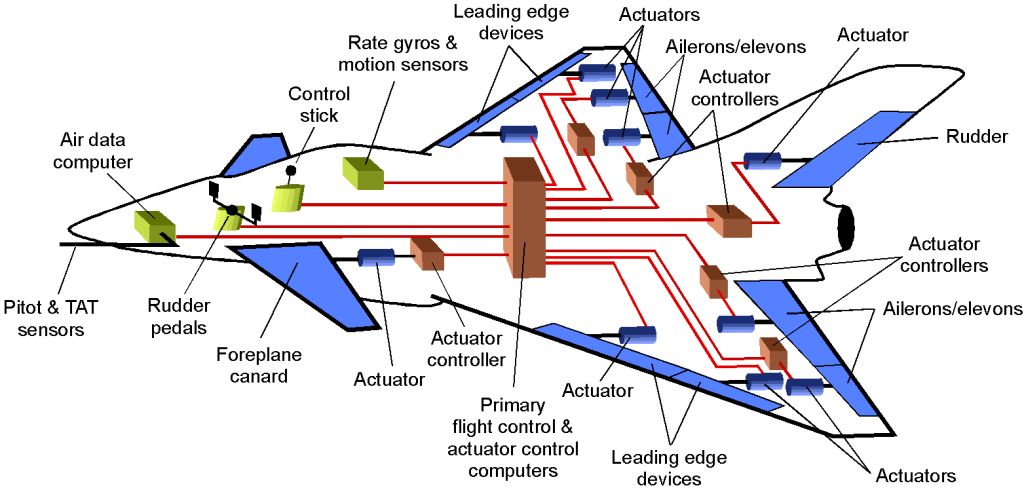
The types of problems and challenges encountered by engineers in the field of aerospace dynamics and control may include the following:
- Understanding and predicting configuration effects on aerodynamics, performance, and stability, as well as predicting aircraft motions in response to different types of control inputs.
- Estimating an aircraft’s flight dynamics characteristics and handling qualities from its estimated geometric and inertial properties is critical in developing flight simulators, especially before a new aircraft makes its first flight.
- The analysis of the linear and nonlinear dynamic representations of all flight vehicles and the development of suitable flight control systems, stability augmentation systems, autopilots, etc.
- Measure and evaluate aircraft handling qualities from flight testing and suggest improvements to the aircraft’s design and flight control systems.
- The design and development of suitable control systems for spacecraft for guidance and navigation.
Systems Integration: Putting It All Together
Testing is a crucial aspect of aerospace engineering, and both individual components and complete systems are tested to ensure their functionality and performance. System integration is the process of combining all subsystems to work in synergy, thereby achieving the system’s overall functionality. This approach requires extensive testing and failure analysis to guarantee the integrity of all components, including structural, mechanical, electrical, electronic, hydraulic, and other elements that comprise the complete system. Testing and system integration play a vital role in ensuring the reliability and safety of aerospace systems, and aerospace engineers are responsible for designing and conducting these tests.
Over the last three decades, aircraft and aerospace systems have become increasingly complex, featuring sophisticated, interdependent components. Consequently, the engineering design process now requires a complete “systems engineering” approach to testing, evaluation, qualification, and certification. The systems engineering discipline generally addresses the complex processes of ensuring engineering functionality, satisfying safety requirements, meeting cost and schedule constraints, and resolving reliability challenges.
Aerospace systems integration is undoubtedly among the most challenging and demanding industry disciplines. System engineers typically have broad backgrounds in aerospace, mechanical, or electrical engineering, with many years of experience; they may or may not be specialists or experts in subsystems. However, a common goal for these engineers is to evaluate aerospace components as part of a unified system, which may require a myriad of tests and other types of analysis, including fault tolerance and redundancy, as well as assessing the risks associated with various types of component failures.

The specific problems and challenges encountered by aerospace systems engineers may include the following:
- Defining methodologies, processes, and other tools to enable the successful definition, development, certification, implementation, and operation of co-dependent aerospace technology components and systems.
- Managing and reducing risks associated with complex technology systems, identifying possible failure modes, and searching for the “unknown unknowns” are key to finding a cost-effective technology systems solution that can meet all design requirements.
- Managing the “Risk-Cost-Safety” balance ensures the final system is fully validated and contains verified hardware and software components.
- Ensuring all systems are adequately certified and meet airworthiness standards.
- Monitoring, operating, and maintaining fielded systems; providing spares; monitoring for obsolescence; and promoting long-term system safety.
Thinking Toward the Future
The future of aerospace engineering offers many challenges and exciting opportunities for those pursuing careers in this field. As students begin to study their chosen field by taking courses in the fundamentals, they will also develop, through their instructors, an understanding of contemporary issues and the methods being used to address them.
Key technical aeronautical thrusts for the future will be to continue to develop new technologies that further improve aerodynamic efficiencies, reduce airframe weight, lead to better fuel efficiency, and limit all types of pollution. Key astronautical thrusts will help to solve space exploration problems, such as revisiting the Moon, developing deep space capabilities, and improving human life support systems. Commercializing space activities by the private sector continues to show that innovative technology solutions can significantly reduce flight costs.
The leading aerospace companies continue to invest in research facilities to develop new technologies that will lead to advancements in performance, reduced manufacturing costs, and improved competitive pricing for their aircraft and spacecraft. The aerospace industry’s future also lies in the enhanced training and technical competency of its engineering workforce, which colleges and universities strive to provide through the education of their students. It is expected that the new graduates of the aerospace field will bring their vision and innovative ideas to make the advances in engineering needed for the future.
Aerodynamics
Aircraft organizations will continue to refine aircraft shapes to improve aerodynamic efficiency. They also research low-drag, smooth “laminar” flow wings, as well as active flow control technology to improve aerodynamic efficiency. Additionally, a deeper understanding of the thin boundary layer on the aircraft’s surface may reduce skin friction drag and enhance fuel efficiency. “Non-stick” wings are being investigated to prevent insects from accumulating on wings and help minimize the aircraft’s drag in regular service. More ambitious efforts, which are still at the basic research stage, include the morphing or “shapeshifting” of wings to optimize their aerodynamic performance over different parts of the flight envelope.
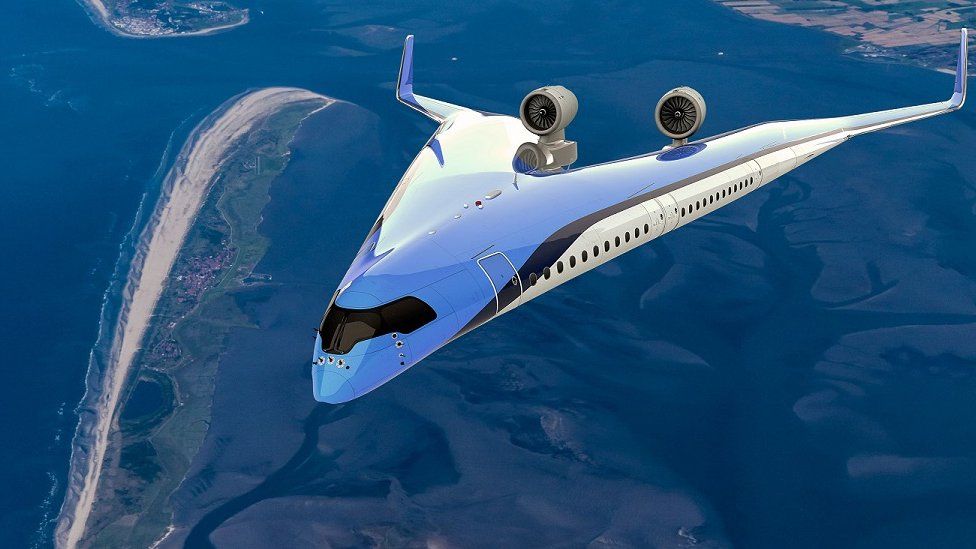
Composite Materials
Large composite structural parts are now used for primary airplane components, such as tails, fuselages, wings, helicopter rotor blades, propellers, and the fan blades on jet engines, as shown in the figure below. However, durability, reparability, longevity, and other issues with composites continue to pose challenges for engineers in the quest for ever stronger and lighter airframes. Additionally, composite materials are generally lighter than conventional metals. Still, the structures from which they are built can be tailored to be more structurally efficient for carrying the same loads.
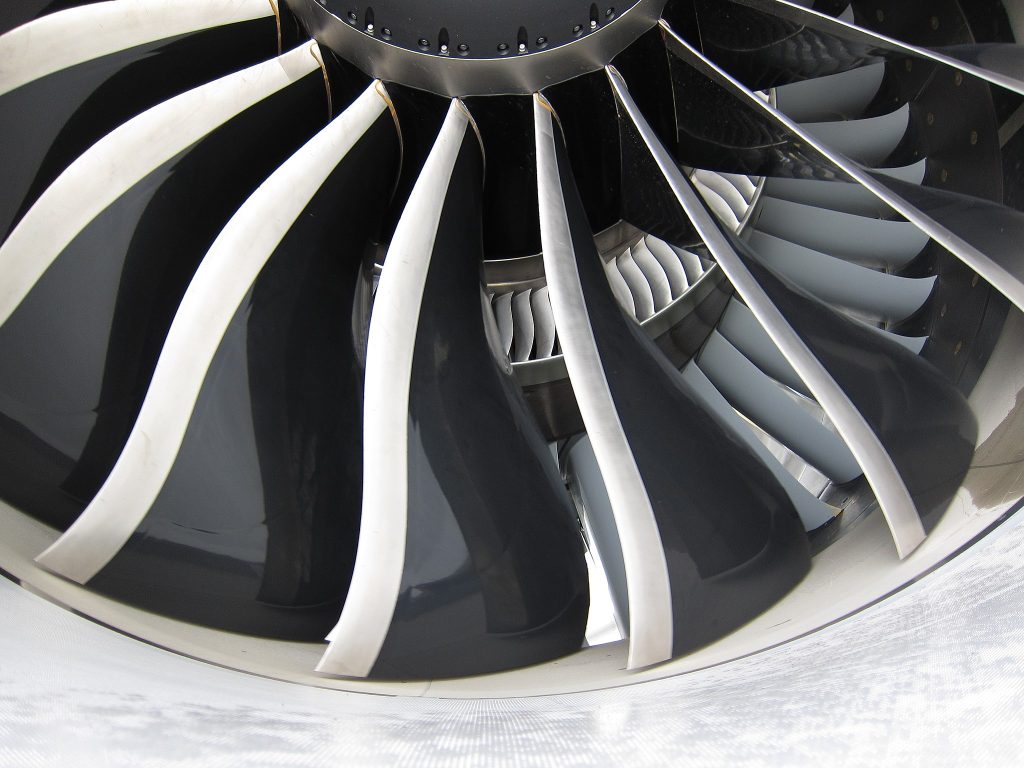
Supersonic Aircraft
Government research labs and the aerospace industry have continued to push for the development of new generations of supersonic transport (SST) aircraft. NASA’s latest program calls for the design and flight testing of a new X-plane to support the development of future generations of SST. However, one major problem is the formation of “sonic booms” from aircraft flying supersonically, resulting in a loud “boom-boom” sound. This startling type of noise is so intense that regulatory aviation authorities currently prohibit the flight of supersonic aircraft over land. That may change when engineers learn how to mitigate the sonic boom problem, for which significant progress has already been made. Another problem is the kinetic heating of the airframe at supersonic speeds, which necessitates special considerations in airframe design and the selection of materials for its construction.

Air-breathing Propulsion
Jet engine design is also expected to undergo changes in the future. Engine manufacturers already utilize additive manufacturing technologies, such as three-dimensional printing, to produce more complex and intricate metal parts that are incorporated into an engine. Research and development will continue to focus on hybrid-electric jet engines, aiming to make them smaller, lighter, and more efficient. More fuel-efficient and environmentally friendly, low-pollution propulsion systems continue to garner significant interest from the aviation community. All types of internal combustion engines produce carbon dioxide, various kinds of small particulate matter, nitrous oxides, and other pollutants that can all have significant long-term effects on the atmosphere. Research and development efforts are underway to explore and implement sustainable aviation fuels (SAFs). These fuels are derived from renewable sources, including biofuels, hydrogen, and synthetic fuels. SAFs have the potential to significantly reduce carbon emissions compared to traditional jet fuels.
Rocket Engines
More powerful rocket engines with greater efficiency will continue to be developed, as well as those utilizing alternative fuels. Traditional fuels, such as Rocket Propellant No. 1 or RP-1 (a type of densified kerosene) and liquid hydrogen, are being replaced by liquid methane or propane, which are attractive because of their excellent availability and performance. Methane and propane are also more environmentally friendly and easier to store than cryogenic liquid hydrogen. Liquid oxygen is generally used as the oxidizer for rocket engines. The SpaceX Raptor rocket engine, as shown below, uses methane and liquid oxygen and will be utilized in both stages of the two-stage-to-orbit, super-heavy-lift launch vehicle called Starship.

Unoccupied Aerial Vehicles
An Unoccupied Aerial Vehicle (UAV), commonly referred to as a drone, is an aircraft that operates without a human pilot, crew, or passengers. Unlike crewed aircraft, UAVs are often preferred for “dull, dirty, and dangerous” (D3) missions. As shown below, many are rotorcraft or S/VTOL capable of providing the required mission flexibility. While UAVs were initially developed for military applications, their use is rapidly expanding into many civil applications. This field is likely to experience significant growth in the coming decades.
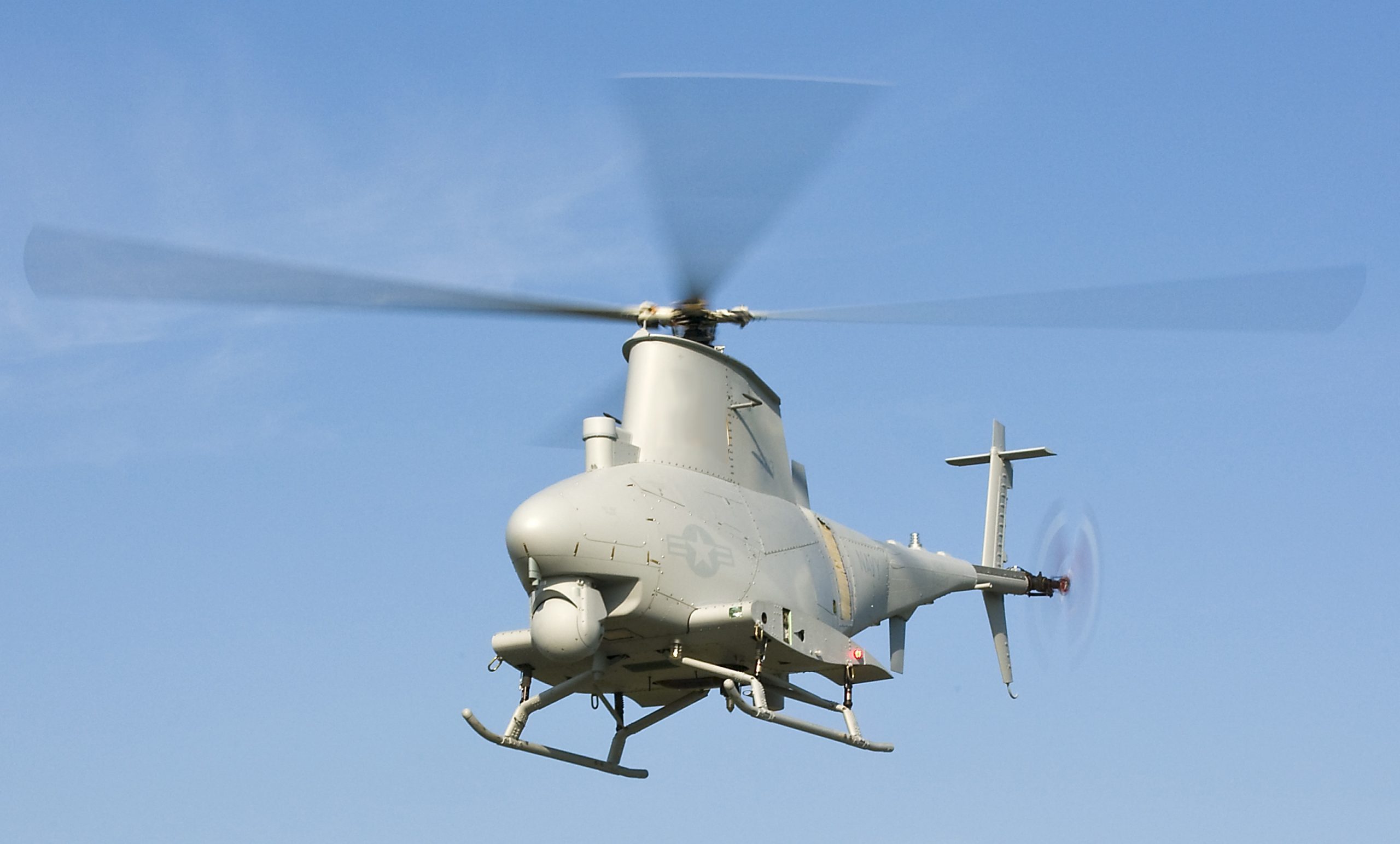
Noise
Millions of people worldwide are affected by aircraft noise, especially those who live and work near airports. Most aircraft noise comes from their engines. Military airplanes, especially those equipped with afterburners, can produce extremely high noise levels. The effects of aircraft noise can even cause vibrations in buildings and structures or disrupt various human activities.
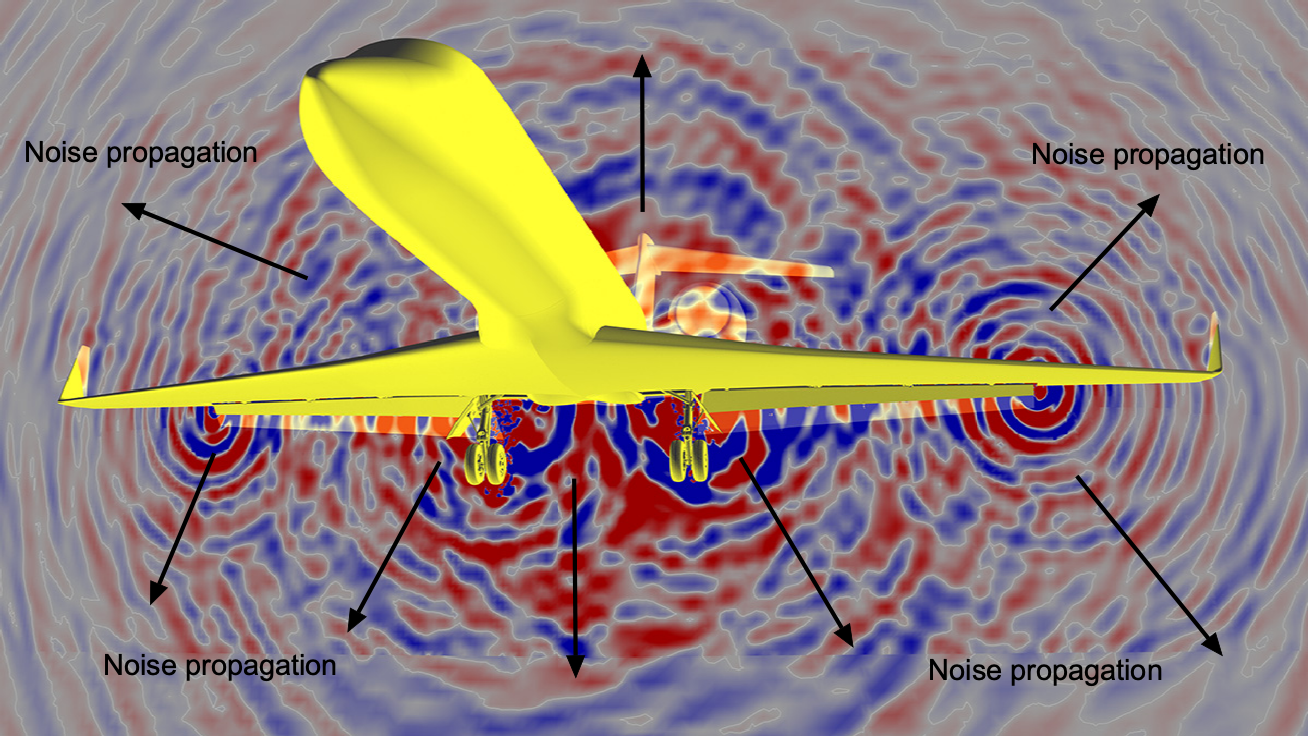
While the noise levels produced by civil aircraft have been significantly reduced in recent years to meet increasingly stringent noise regulations, numerous technical issues remain to be addressed to further reduce the noise of future aircraft. Advancements in aircraft design, including quieter engines and improved aerodynamics, help mitigate the noise impact on communities near airports. Noise is the main issue stifling major airport expansion or new construction; in the U.S., Denver International has been the only major airport built in the last 40 years.
Sustainability
Sustainability is a much-used word in today’s aerospace industry, but what does it mean? Sustainability means following practices that can meet the needs of the present generation without compromising the needs of future generations. This responsible approach entails adhering to sustainable practices and considering the long-term impact on the environment, society, and the economy. Because aerospace is one of the most technologically advanced and resource-intensive industries, aerospace sustainability must continue to focus on minimizing the environmental impact of aircraft manufacturing, operations, and end-of-life disposal, while also addressing social and economic considerations.
Aerospace organizations continue to develop environmental management systems to monitor and continuously improve their sustainability performance. These systems help identify areas of improvement, set targets, and ensure compliance with environmental regulations. Evaluating the environmental impact of aircraft throughout their life cycle is essential, and factors such as raw material manufacturing processes, operational efficiency, and end-of-life disposal must be considered. Aerospace companies increasingly focus on recycling materials, reducing waste generation during manufacturing processes, and implementing proper disposal methods for end-of-life aircraft components.
Sustainability for Students
Engineering students can significantly impact sustainability by adopting environmentally responsible practices and principles into their education and lifestyle. Students should gain a deeper understanding of the environmental challenges facing the aerospace industry and society. Studying topics such as carbon emissions, noise pollution, and resource depletion, including aviation-related issues, is crucial. Students should also learn about and advocate for integrating renewable energy sources into aviation, such as electric propulsion or alternative fuels like hydrogen and biofuels. Staying informed about environmental policies and regulations is crucial for engineers entering the aerospace industry, as these issues will become increasingly important in the coming decades. In the short term, students can learn about applying sustainability principles in their daily lives by reducing their carbon footprint through energy conservation and recycling plastics and other products. In particular, never dispose of batteries in the trash – cover the terminals with tape and place the batteries in a recycling container at your institution or the nearest recycling station.
Being a Successful Engineer
“Let the young engineer then be convinced that the profession which he studies is not a mere profitable business, but a liberal and noble art, tending towards great and good ends, and that to strive to the utmost to perfect himself in that art, and in the sciences on which it depends, is not merely a matter of inclination or policy, but a sacred duty.“
Formula for Success
Becoming a successful engineer requires hard work and extensive practice. It can perhaps be described by the following formula, adapted after Professor Winston at MIT, i.e.,
where one’s success, , primarily depends on the cumulative sum of one’s engineering knowledge
, deliberate practice
, and contextual insight
, all integrated over time
, the period being one’s career in the profession. The
term, which is outside the time integral, represents one’s innate talent or aptitude, which may manifest as a natural affinity for mathematics, scientific reasoning, or abstract problem-solving. While the formula above conceptualizes success, measuring it involves many practical metrics tailored to one’s specific goals and career aspirations. Ultimately, however, the measure of one’s success in engineering (or any other field, for that matter) may depend on the judgment of others.
- Notice that the
term in the foregoing formula is small because people are not genetically predisposed to be engineers, nor are they predisposed to success in most professional fields. However, most people who reach this stage in an engineering program already possess some degree of innate talent in mathematics and the sciences. The placement of this term outside the integral emphasizes that while natural aptitude can support success, it is not the defining factor; sustained effort and learning are more important. As Richard Feynman said, “I was an ordinary person who studied hard.” Feynman argues that there is no such thing as talent; one can achieve whatever one wants by working and studying hard.
- The acquisition of knowledge, represented by
, forms the theoretical foundation and technical expertise gained through education and learning. This process eventually generates an understanding of one’s field, presumably a specialty in aerospace engineering, meaning that sufficient knowledge has been gained to do something useful with it. For example, obtaining a degree or a professional qualification can be viewed as the acquisition of knowledge, and so it is one measure of success. Continual learning throughout a lifetime is crucial for acquiring knowledge and achieving a deeper understanding, as engineering fields are dynamic and constantly evolving with advancements and innovations.
- Practice and context, represented by the
and
terms, respectively, begin in college or university with homework problems, where one starts to engage with the foundational methods and exemplars of the field. Continued application of one’s knowledge to increasingly complex problems refines skill, builds experience, and strengthens overall problem-solving ability. Context and practice reflect their complementary roles: context provides the framing and relevance, while practice develops fluency and confidence. Both are essential for deep learning, and both enhance knowledge, i.e.,
If either component is absent, then understanding is diminished, and if one’s knowledge is insufficient, there can be little or no understanding at all.[1]
For example, in mathematics, knowledge refers to the facts and rules that are learned, while understanding is derived from applying those facts in the appropriate context. Learning mathematics also requires much practice. Consider the equations: ,
,
, and
. At first glance, only the first appears correct if we assume all the equations are written in base 10. However, numbers can be expressed in different bases, and the meanings change accordingly. In binary (base 2),
. In octal (base 8),
. In hexadecimal (base 16),
. So, all of the equations are technically correct. The knowledge needed here is familiarity with how different number bases work. Understanding comes from recognizing which base is being used and interpreting the equations accordingly. What at first seems nonsensical becomes correct once the right context is applied.
Therefore, a measure of a person’s success, however it is measured, is what they learn and the knowledge they acquire over time. This journey begins now and will continue throughout one’s career. Success is a marathon, not a sprint. According to Professor Winston, what matters most is what one writes, how one speaks, and the overall quality of one’s work.[2] There is no single path to follow for success, but there are established steps that countless generations of engineers have followed to achieve it. To this end, some general goals are:
- Start early: Build a solid foundation of knowledge and become comfortable with problem-solving.
- Embrace lifelong learning: Keep up-to-date with advancements in one’s field.
- Focus on communication: Writing, speaking, and presenting ideas effectively are crucial for career growth.
- Quality of work: Consistently aim for excellence in all projects and endeavors.
Pyramid of Success
The Pyramid of Success, illustrated in the figure below and advocated by Professor James D. Jones at Purdue University, offers guidance on best practices for engineering students.
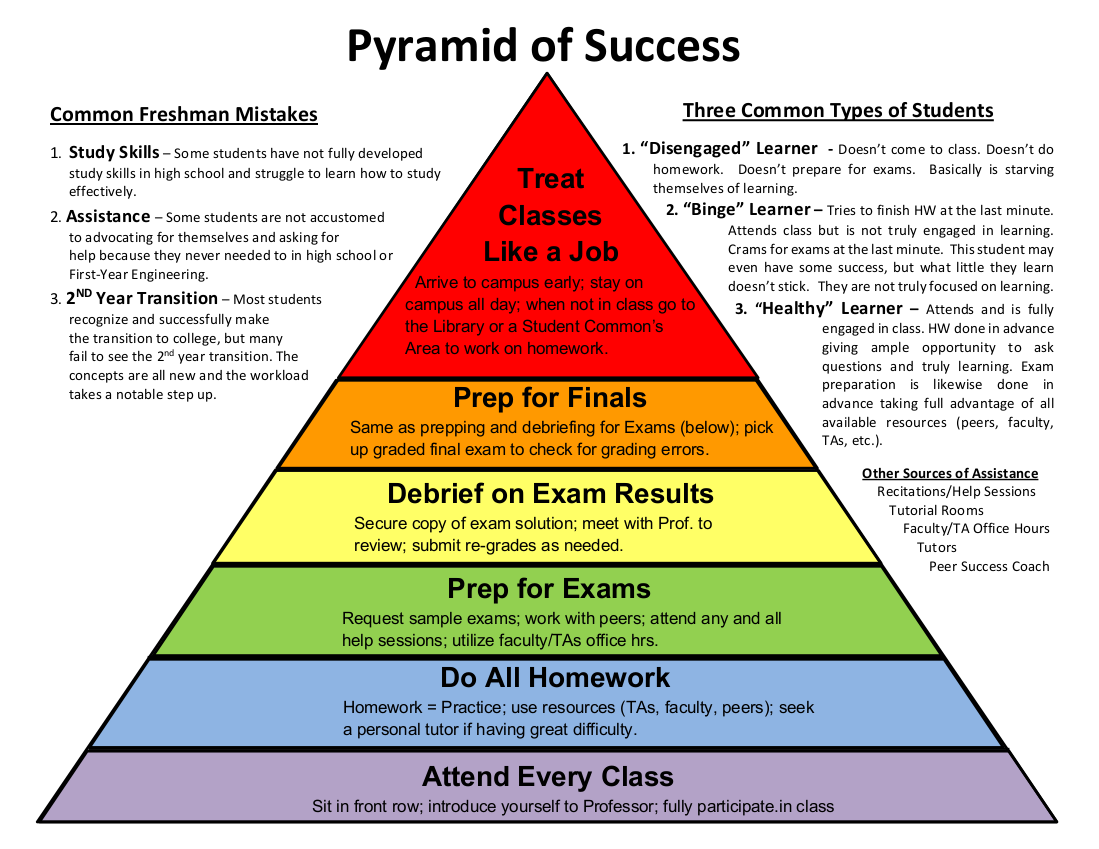
ERAU’s Dr. James Ladesic’s “Tenets of Success” for engineers is also important to follow; it applies equally to students taking courses and practicing engineers in the workplace. These tenets align with the general theme of the Pyramid of Success.
Dr. Ladesic’s Tenets of Success
- Volunteering for assignments.
- Planning ahead.
- Sharing workloads equitably.
- Maintaining and projecting a positive attitude.
- Working diligently.
- Participating productively in group and class activities.
- Responding to project demands in a timely fashion.
- Behaving ethically.
- Generally, take responsibility for yourself, your work, and your spoken and written statements in a professional engineering manner.
Goal Setting
Goal setting is also a crucial component of professional development. The career goals of an aerospace, aeronautical, or astronautical engineer might include the following.
Shorter-Term Goals:
- Gain hands-on experience in the aerospace industry by working as an engineer at a large aerospace company or a startup.
- Develop expertise in a specific area of aerospace engineering, such as aerodynamics, structures, propulsion systems, or spacecraft design.
- Attend industry conferences and events to network with other engineers and stay up-to-date on the latest developments in the field.
- Participate in continuing education courses to expand your knowledge and stay current with the latest technologies and best practices.
Longer-Term Goals
- Obtain an advanced degree in aerospace engineering, such as a Master’s or Ph.D., to increase expertise and improve career opportunities.
- Work on high-profile aerospace projects, such as human spaceflight missions or the development of new aircraft technologies.
- Take a leadership role in an aerospace company, such as a team leader, project manager, or department head.
- Contribute to developing new technologies and advancements by conducting research and publishing papers.
Internships
Internships offer aerospace engineering students numerous advantages, providing hands-on experience that applies theoretical knowledge in real-world contexts. Exposure to industry practices enhances understanding of classroom material, while skill development in CAD and CFD software prepares students for professional challenges. The networking opportunities foster connections with industry professionals, contributing to future job prospects and mentorship possibilities. Internships also help develop proactive attitudes and the ability to apply classroom knowledge in real-world settings. Additionally, they facilitate career exploration, enabling students to discover specific interests within the broad field of aerospace engineering, and provide insights into industry trends, ensuring they are well-prepared to enter the workplace upon graduation.
Advanced Degrees
Obtaining an advanced degree in aerospace engineering can offer significant advantages to an engineer’s career, including increased expertise, improved job opportunities, and the ability to take on more challenging and high-profile projects. Additionally, advanced degrees can open up opportunities for leadership and research positions, allowing engineers to contribute to the advancement of the field and shape the future of aerospace engineering. Pursuing an advanced degree is a challenging decision, but it’s never too early to plan ahead.
Summary & Closure
Aerospace engineering is a complex and interdisciplinary field that requires a comprehensive understanding of many core subjects. Aerospace engineers must continually expand their knowledge and expertise to stay current with this rapidly evolving field. Engineers apply scientific and mathematical principles to tackle complex challenges and create innovative new designs and design improvements. The key aeronautical advancements include aerodynamic efficiency, weight reduction of the airframe, improved fuel efficiency, and reduced pollution. Recent developments have led to the emergence of new aeronautical technologies, including electric and hybrid propulsion systems.
Aerospace engineering presents numerous opportunities for growth and innovation, making it an exciting career choice for individuals interested in this field. With increasing focus on space exploration, missions to revisit the Moon and perhaps even Mars are expected to accelerate. Moreover, commercializing spaceflight activities has demonstrated that cost-effective technology solutions can enable much broader access to space. The field of astronautics is expected to be marked by numerous exciting new developments, increasing the understanding of the universe.
5-Question Self-Assessment Quickquiz
For Further Thought or Discussion
- Think more about how quickly aeronautical engineering has evolved in the last century. Where do you think the field of aeronautical engineering will be in another century? What types of new aircraft do you think will be flying then?
- Human colonization of space remains a hugely ambitious goal. NASA’s return to the Moon has begun with its Artemis program. Make a list of some of the technical and other challenges in sending humans back to the moon, Mars, and perhaps even deep space. You may also explore the need for power generation, human life support systems, and resource management in the harsh Mars environment. Remember also that Mars is over 250 times farther away than the Moon.
- How have competitions and monetary awards historically influenced the pace and direction of innovation in aviation, and what lessons can modern aerospace industries learn from these examples to foster future advancements?
- Explore and discuss the engineering challenges and advancements in designing aircraft capable of supersonic and hypersonic speeds. Discuss potential applications, such as high-speed travel and military surveillance. How are issues such as “sonic booms” from supersonic flight vehicles being addressed?
- Do some research and discuss the development of electric propulsion systems for aircraft. Explore the potential for electric aircraft to reduce environmental impact and increase efficiency. Why might the realization of electrically powered airliners traveling over large distances be decades away, if at all?
- Discuss the impact of the COVID-19 pandemic on the aerospace and aviation industry. For example, the pandemic led to a significant decrease in air travel demand, resulting in grounded fleets of airliners. Lockdowns also disrupted global supply chains, affecting the production of aircraft and aerospace components.
- Goal setting is a crucial component of professional development. Think about your goals as a future aerospace engineer and where you might want to position yourself in the workforce five, ten, or even twenty years from now.
- Aerospace engineers inevitably specialize in one or more fields, such as aerodynamics, controls and flight mechanics, structures and materials, propulsion, etc. Think about what area of specialization might interest you the most and list the specific courses of study you believe are needed for that specialization.
- Many aerospace employers prefer to recruit a fraction of new engineers with a Master’s degree or suggest that their engineers pursue online graduate courses. Consider some potential advantages and disadvantages of being in the workforce with an advanced degree. Hint: An advanced degree may not necessarily be in the engineering field.
Other Useful Online Resources
For more information on aerospace engineering and what aerospace engineers do:
- Video on “What is Aerospace Engineering?”
- Video on “What is Aerospace Engineering (Aeronautics).
- Video on “What is Aerospace Engineering (Astronautics).
- Why, yes, actually, it is rocket science – watch these fun TED videos
- The U.S. Bureau of Labor Statistics runs a good website about the field of aerospace engineering.

